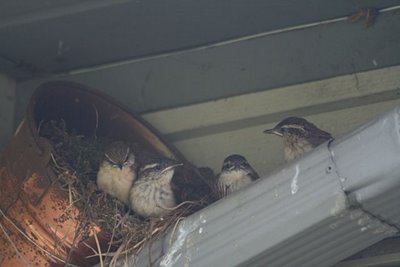 I’ve written about the little copper bucket under our eave. In the 1950’s and early 60’s, it held a philodendron plant that trailed around the stone fireplace in our home in Shawnee Mission, Kansas. Somehow it got passed on to me, and I’ve thrown it in with my stuff and moved it a dozen or more times. It reminds me of my mom.
I’ve written about the little copper bucket under our eave. In the 1950’s and early 60’s, it held a philodendron plant that trailed around the stone fireplace in our home in Shawnee Mission, Kansas. Somehow it got passed on to me, and I’ve thrown it in with my stuff and moved it a dozen or more times. It reminds me of my mom.One day, about five years ago, I saw a Carolina wren trying to make rootlets, leaves and grasses stay on the elbow bend of the downspout by our front door. He’d bring a bunch of stuff, only to see it slide off; I noticed it by seeing a trailer of skeletonized leaves and rootlets hanging down in front of the foyer window.
I caught the wren’s eye as it perched on the gutter. “Hang on. I’m going to help you. I’ll be back in just a minute.” I went to the garage and got my 8’ stepladder and the little copper bucket, a roll of utility wire, a hammer and roofing nail. Climbed up the ladder, drove the nail, wrapped wire around it and secured the bucket up under the eave, where no rain could get into it. Took the nesting material, laid it in the bucket, and climbed down the ladder. Before I had so much as folded the ladder, the wren, who had been watching the whole operation, was hauling moss and trash to that bucket. By nightfall, he had a nest nearly complete. There was no hesitation whatsoever—just immediate, presumably grateful acceptance of my gift.
Having watched a black rat snake climb partway up the gutter two years ago (and removed said snake to another part of the yard), I’d hit upon a way to secure the nest. I wedged a big, heavy cardboard mailing tube between the gutter and the house, which keeps any snake from wrapping itself around the gutter and gaining access to the nest. It’s perfect. So I’m always thrilled to find Carolina wrens setting up housekeeping for a first and often a second brood in the little bucket. Carolina wrens keep the cleanest nest I know; I’ve never found one infested with parasites.
The wrens were sneaky this year, but I knew by the increasing size of the food items they brought that their chicks were nearing fledging. Finally I heard the chicks' sibilant, soft piping change to a squeaky chdeek! –the fledging call, the rally to flight.
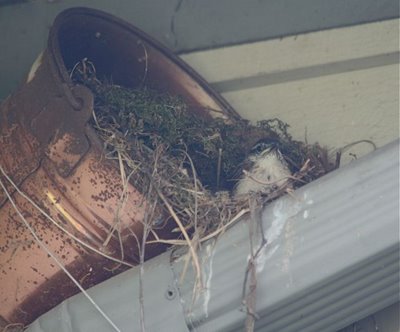 The first baby got a peek at the world, and stayed out front for most of the day.
The first baby got a peek at the world, and stayed out front for most of the day.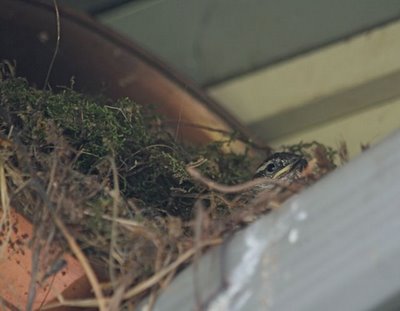
By the next morning, they were lined up on the downspout, sizing up the world. It wouldn’t be long now.
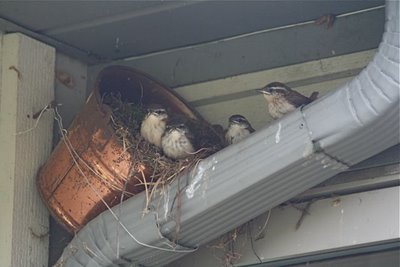
Fluttering and clambering, they scrambled up and onto the bucket top.
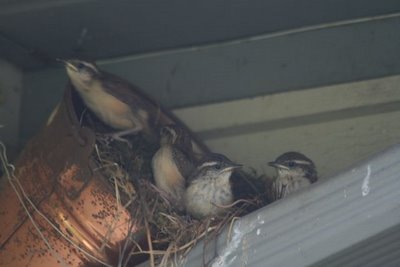 One of them was going to have to try its wings by default.
One of them was going to have to try its wings by default.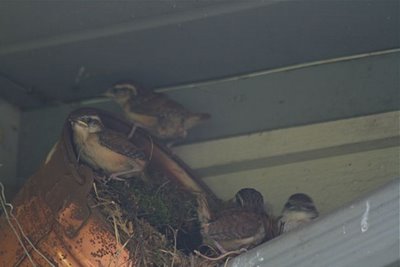 The first buzzed off, crash-landing in the hostas, and four others soon followed.
The first buzzed off, crash-landing in the hostas, and four others soon followed.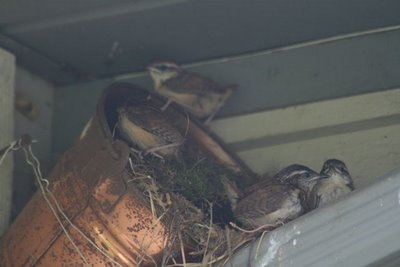
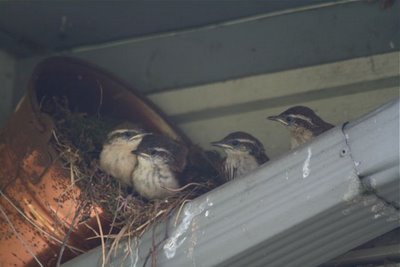 The fifth chick (still in the nest in this picture) stayed for awhile. Awhile being a couple of hours. This was a bad choice on its part.
The fifth chick (still in the nest in this picture) stayed for awhile. Awhile being a couple of hours. This was a bad choice on its part. 





13 comments:
What a great use for such a lovely bucket. I love their eye makeup.
Oh, how wonderful, and kudos to you for being such a good friend of the birds.
Hooboy, this is what bird-blogging is all about. Lovely, lovely pics!
What??? Don't leave us hanging!! How will I be able to wait for the conclusion of "Bad Decision at Copper Bucket"?
~Kathi, who has all sorts of nesting birds in all stages, but sadly, no Carolina Wrens
I do love a mystery. Can't wait to read "Science Chimp to the Rescue." I keep wondering what happened to the last chick, but based on the title, I'm sure the outcome will be a good one.
Wonderful photographs and great post.
Julie - just love these photos of your baby Wrens! I see an amazing painting coming from these shots!
Baby wrens are adorable. Science chimp, you need to tell us the rest of the story! What happened to the 5th chick? And the ones that landed in the hostas, are they doing OK now?
Tell me more, tell me more etc. (from Grease).
Anyway, so already--tell me more!
Can't wait to hear the outcome of a poor decision! You left us hanging...
That is just about the cutest thing ever Julie! I love it! So, when will the watercolor be available... wink, wink. :c)
1950'S CLIFFHANGER.
Come next Saturday for the next installment.
You're such a tease Julie.
Do you clean out the bucket between nestings? Our C. wrens have fledged and I am not sure if I should remove the nest. It's tucked in a corner below our deck, built on a stored birdbath/fountain before I could get it out this spring!
Gosh Julie, what an adorable family. It will be pretty quiet around home now that they've moved out!
Post a Comment